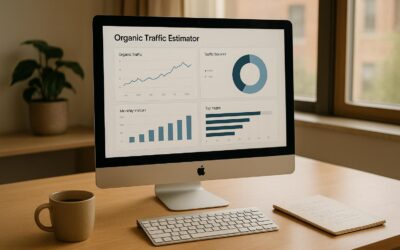SEO is most effective when guided by data. Analytics tools help you refine your strategy by identifying what works, what doesn’t, and where to focus your efforts. Since 53% of web traffic comes from organic search, but 95% of users never go past the first page, aligning SEO with business goals and using analytics is critical.
Key Takeaways:
- Set measurable goals: Use SMART criteria (Specific, Measurable, Achievable, Relevant, Time-bound) to turn business objectives into actionable SEO targets.
- Benchmark performance: Use tools like Google Analytics and Search Console to track metrics like organic traffic, conversions, and keyword rankings.
- Analyze data: Identify high- and low-performing areas, segment data by audience behavior, and adjust based on trends or seasonal patterns.
- Review regularly: Monitor performance weekly and revise goals every 3-6 months to stay competitive with algorithm updates and market changes.
By consistently analyzing metrics and refining your approach, you can drive better results and ensure your SEO efforts align with your business priorities.
How To Interpret Google Analytics Goal Setup (2025)

How to Align SEO Goals with Business Objectives
To make your SEO efforts truly impactful, they need to tie directly to your business priorities, like boosting revenue, generating leads, or building brand authority. It’s not just about driving traffic – it’s about attracting the right audience who will take meaningful actions on your site.
For example, a SaaS client shifted their focus from high-volume keywords to high-intent ones, optimizing key pages for better conversions. The result? A noticeable traffic increase within just a few months.
Identify Your Business Priorities
Start by mapping out your short- and long-term goals. Whether you’re planning a product launch, aiming for a specific revenue target, or looking to expand into new markets, these priorities should guide your SEO strategy.
Your focus will determine how you allocate resources. For instance:
- If lead generation is your top priority, concentrate on high-intent keywords and refining conversion paths.
- If brand awareness is the goal, invest in creating broad, educational content that builds trust and authority over time.
Target keyword themes that align with every stage of the customer journey, especially for revenue-driving products. Also, keep an eye on key metrics like customer acquisition cost and lifetime value. Organic traffic that converts well can justify a higher investment in SEO.
Once you’ve clarified your business priorities, use them to set clear, measurable SEO targets.
Convert Objectives into Measurable SEO Goals
Turn your business goals into SMART SEO goals – Specific, Measurable, Achievable, Relevant, and Time-bound. For example, instead of aiming to "increase traffic", set a goal like boosting organic traffic to key pages by 15% in Q4.
Track performance metrics such as:
- Rankings
- Click-through rates (CTR)
- Time on page
- Conversion rates
Use data from analytics platforms to monitor progress and tweak your strategy as market conditions shift. For example, cross-referencing keyword performance with conversion data can reveal which terms are driving real business results.
Time-bound goals add urgency and structure. If your goal is to grow organic leads by 25% in six months, set monthly benchmarks to track your progress. Align your keywords with customer intent – focus on awareness at the top of the funnel and purchase intent at the bottom. Regularly review performance data to ensure your SEO goals stay in sync with your business objectives.
How to Review and Benchmark Current SEO Performance
Before refining your SEO goals, it’s crucial to gather baseline data and set benchmarks. This data serves as a foundation for informed decision-making. Start by connecting Google Analytics and Google Search Console to get a comprehensive view of your site’s performance. In Google Analytics, filter for organic traffic from Google to identify which pages resonate most with your audience. Meanwhile, Google Search Console’s Performance reports provide insights into traffic trends and search visibility, helping you tie conversions to specific efforts. Once you have this baseline, focus on the metrics that truly impact your business.
Key Metrics to Track
When reviewing SEO performance, prioritize metrics that directly influence your business outcomes: organic traffic, organic clicks, conversion rates, and keyword rankings.
- Organic traffic: This metric, measured through sessions, reflects how well your SEO efforts attract relevant visitors.
- Organic clicks: Use Google Search Console to track which keywords drive traffic and evaluate their performance.
- Conversion rates: Set up key events in Google Analytics – like purchases, sign-ups, or form submissions – to determine the quality of your organic traffic.
- Keyword rankings: Regularly monitor rankings to see how well your target keywords are performing.
Additionally, keep an eye on technical metrics like Core Web Vitals to ensure a fast and seamless user experience. Check for crawl errors that might block Google’s ability to index your site. Engagement signals, such as time on page or bounce rate, can also reveal how valuable your content is to users.
"SEO metrics are your agency’s scoreboard – they tell you what’s working, what needs improvement, and how to get better results for your clients."
- Joe Kindness, Founder & CEO at AgencyAnalytics
It’s worth noting that 67% of all clicks go to the first five organic results. By tracking click-through rates, you can fine-tune page titles and meta descriptions to capture more of these clicks. Once you’ve benchmarked your current performance, use historical trends to guide your next steps.
How to Use Historical Data and Seasonality
Historical data adds depth to your benchmarks, revealing patterns and opportunities for growth. By analyzing past keyword ranking data, you can predict ranking shifts, refresh content before it loses relevance, and make timely updates. For example, reviewing how long similar keywords took to rank in the past helps set realistic timelines, as SEO often requires 3–6 months to show results.
Seasonality also plays a major role in search behavior. Consumer interests change throughout the year, influencing which keywords gain traction at specific times. For instance, "Halloween costume ideas 2024" might see a search volume of 3,800, with spikes in September and October. It’s essential to distinguish between normal seasonal dips and actual performance issues – traffic drops aren’t always a cause for concern.
Use historical data to pinpoint when your traffic consistently peaks or slows down. Tools like Google Trends can help you track keyword popularity over time and identify regional differences in seasonal interest.
"Seasonal trends are not always obvious. Failing to consider them when analyzing site traffic or creating an SEO report could end up wasting a lot of your time and resources."
- Munene Mumbi, SEO Manager at WordLift
To make the most of seasonal trends, start planning campaigns at least three to four months in advance. Update key pages based on historical keyword data before the seasonal surge begins. Align your link-building efforts with rising interest and avoid over-optimizing during slower periods, as these dips often resolve naturally .
A great example comes from a tech news website that closely monitored Google Search Console daily. They noticed a spike in impressions but low clicks for product reviews. After identifying that a competitor had implemented review structured data to earn rich snippets, they quickly followed suit. Within two weeks, they regained their click-through rates.
Establish a consistent monitoring routine with daily, weekly, and monthly checks. This practice helps you spot opportunities early and respond to changes before they significantly affect your performance.
sbb-itb-880d5b6
How to Analyze Analytics Data for Adjustment Opportunities
After setting benchmarks and understanding historical trends, the next step is diving into your analytics data to uncover areas that need improvement. A detailed analysis can turn basic observations into actionable steps, helping you fine-tune your SEO strategy. By examining patterns in user engagement, conversion paths, and performance across different segments, you can pinpoint what’s working well and where adjustments are needed.
Find High-Performing and Low-Performing Areas
Start by reviewing the GA4 Landing Pages report to identify pages with strong engagement and conversion rates. Key metrics to focus on include Engaged Sessions, scroll depth, and session duration. High-performing pages with these metrics often highlight content that connects well with your audience.
For pages that aren’t performing as well, look for signs like session durations under two minutes or bounce rates above 55%. These indicators often suggest that the content isn’t meeting user expectations or aligning with their intent. Use the path exploration report in GA4 to see how new users navigate from your homepage to other parts of your site. This data can help you understand which content successfully keeps visitors engaged.
Pay extra attention to pages meant to attract organic search traffic. Check if the traffic landing on these pages is actually coming from organic sources. If a page ranks well but receives minimal organic traffic, there could be a disconnect between your target keywords and how users are searching.
For example, The Home Depot analyzed their website traffic to identify regions generating the most activity and sales. They then created location-specific pages using local search terms and focused on building backlinks in these areas. This approach boosted both organic search traffic and sales in targeted regions.
Once you’ve identified problem areas, take action. Test different layouts, calls-to-action, or content structures through A/B testing on key pages. For pages with low Engaged Sessions, ensure the content is relevant, up-to-date, and easy to navigate. These insights can help you refine your SEO strategy, driving continuous improvement.
Segment Data for Better Insights
After identifying high- and low-performing pages, segmenting your data can reveal more targeted opportunities for improvement. Data segmentation involves breaking down website visitors into groups based on factors like demographics, location, behavior, and interests. This approach helps uncover patterns that might be hidden in overall data and shows how different types of users interact with your content.
Demographic segmentation, for instance, lets you tailor content to specific age groups, income levels, or educational backgrounds. Coca-Cola used this method to target young adults aged 10 to 40. By creating campaigns with language and visuals suited to this group and focusing on platforms like Instagram and Snapchat, they saw increased engagement and loyalty.
Geographic segmentation is especially useful for local SEO. Analyze which regions bring in the most traffic and conversions, then create localized content and build citations in those areas. This is particularly effective for businesses with physical locations or region-specific services.
Behavioral segmentation often provides the most actionable insights. For example, Airbnb analyzed their traffic to identify highly engaged users likely to book stays. They pinpointed the long-tail keywords these users searched for and created optimized landing pages targeting those keywords. This strategy led to increased organic search traffic and bookings.
Look for patterns in how different segments interact with your content. For example, users arriving through specific keyword groups might show varying engagement or conversion rates. A click-through rate above 3% is generally solid across industries, though it can differ between segments.
Keep an eye on session duration and pages per session for each segment. If certain groups consistently show lower engagement, investigate whether your content meets their specific needs and search intent. Tools like Google Trends can help you track keyword interest spikes across regions or demographics. Regularly analyzing segmented data ensures your SEO strategy stays aligned with evolving user behavior and market trends, helping you refine your goals and maximize results.
How to Set, Monitor, and Adjust SEO Goals
After analyzing your data and pinpointing opportunities, the next step is to establish, track, and refine your SEO goals. Building on earlier discussions about performance benchmarks, this process helps turn insights into actionable targets for your SEO strategy.
Create Specific SEO Goals
Good SEO goals stick to the SMART framework – they’re specific, measurable, achievable, relevant, and time-bound. Instead of vague targets like "increase website traffic", aim for precise objectives that your analytics can validate.
Start by reviewing historical data in tools like Google Analytics or SEMrush to establish realistic benchmarks for metrics like traffic, conversion rates, or keyword rankings. For example, if your organic traffic grew by 10% over the past six months, you might aim to increase it by 25% in the next six months. This creates a clear, measurable goal that builds on your existing momentum.
Focusing on fewer, high-impact goals can yield better results. Mike Lowe, Founder & CEO of Growthsaloon.com, suggests:
"Many SEOs go back and forth on this one. But I’ve found it’s better to try to rank high for 1 keyword rather than try to rank decently for multiple keywords. If you match your H1 and your Page Title, Google can better understand what your page is about. My motto is that it’s better to rank Top 10, Top 3, or #1 Overall for 1 keyword – instead of ranking on Page 2 and beyond for multiple keywords."
Use analytics to zero in on high-performing keywords and set specific content goals. Don’t overlook technical performance – just a one-second improvement in page load time can boost online revenue by 7%. For B2B SaaS companies, aim for conversion rates around 1.1%, which is considered average for the industry.
Tracking your progress is essential to measure the ROI of your SEO efforts. Companies like Victorious have seen notable success with this approach, increasing online sales from organic traffic by $3 million year-over-year.
Track Progress with Analytics Dashboards
To monitor progress effectively, set up dashboards that align with your business goals. Tools like Google Analytics, SEMrush, Ahrefs, or SE Ranking can help. For a more comprehensive view, integrate multiple data sources – like combining Google Analytics with Google Search Console.
Focus on actionable KPIs tied directly to your goals, such as organic traffic growth, keyword rankings, backlink acquisition, page load speed, and click-through rates. Use visuals like bar or pie charts to make trends easier to understand and customize dashboards to display only essential metrics.
Jonas Meister, Digital Marketing Strategist at GnuWorld, highlights the benefits of well-designed dashboards:
"The biggest benefit is the time saved in terms of data collection. It’s also great that the design is very pretty out of the box."
Dave Ashworth, Technical SEO Consultant at Organic Digital, adds:
"DashThis allows me to quickly and easily get my clients key multi-channel performance metrics in one easy to digest report!"
Automate alerts for significant metric changes. Tailor dashboard views for different stakeholders – executives may prefer high-level traffic and revenue data, while SEO teams need detailed keyword and technical metrics.
To see how SEO integrates with broader marketing efforts, include data from PPC and social media campaigns. Tools like heatmaps and session recordings can also reveal opportunities to improve calls-to-action and page layouts.
With your metrics in place, review them regularly to identify when tweaks are needed.
When and How to Adjust SEO Goals
SEO strategies must evolve to keep up with algorithm updates, user behavior changes, and market competition. Google makes over 600 updates annually, so revisiting your strategy every three to six months is crucial.
Weekly monitoring of key metrics – like keyword rankings, organic traffic, conversion rates, and engagement – helps you spot trends early. Pay attention to bounce rates, click-through rates, domain authority, and Core Web Vitals. This frequent analysis ensures you can act before small issues become major problems.
Certain red flags signal it’s time to revise your SEO goals:
| Warning Sign | Action Required |
|---|---|
| Declining organic traffic | Conduct site audit and competitor analysis |
| Lost rankings to competitors | Update content and on-page optimization |
| Poor conversion rates | Re-evaluate content and calls-to-action |
| Algorithm updates | Adjust strategy to match new requirements |
| Changing user intent | Adapt keyword targeting and content focus |
When making adjustments, start with a comprehensive site audit using tools like Screaming Frog to uncover technical issues, broken links, or duplicate content. Use Google’s PageSpeed Insights or Search Console to identify pages with slow load times that need optimization.
Competitor analysis can also help. Study what competitors are doing differently and look for gaps in your own strategy. Platforms like Reddit, Quora, and Google Trends can provide insights into what topics matter most to your audience. Heatmaps and session recordings can show how users interact with your content, offering clues for improvement.
Schedule quarterly SEO audits at a minimum, though larger sites may need more frequent reviews. During these audits, make sure your keywords align with user intent and keep your content updated. Google values fresh content as an indirect ranking factor.
Conclusion: Use Analytics for Better SEO Results
Leveraging analytics to refine your SEO strategy is a must for achieving sustainable success in today’s competitive online environment. With over 68% of all online experiences beginning with a search engine, the urgency of getting SEO strategies right cannot be overstated.
Taking a data-driven approach replaces guesswork with actionable insights. As Louise Savoie puts it:
"Analytics is critical in measuring SEO service success because it shows what’s working and what’s not. It gives you data-backed insights into traffic, rankings, engagement, and conversions – helping you make smarter, faster decisions."
The fact that 96.55% of online content fails to receive any organic traffic from Google underscores the importance of continuously fine-tuning your strategy based on performance metrics.
Consistent monitoring is key to staying ahead. Search engines are always updating, and user behavior evolves rapidly. By tracking key indicators like organic traffic, keyword performance, and conversion rates, you can identify trends early and adapt before minor issues escalate. This proactive mindset not only helps you evaluate your return on investment but also ensures your SEO efforts deliver measurable results. It’s no surprise that 88% of marketers with an SEO strategy plan to maintain or grow their investment in 2024, reflecting the value businesses place on analytics-driven strategies.
Analytics also brings clarity and accountability to your SEO efforts. By translating complex data into straightforward action points, you can clearly demonstrate how your work contributes to business growth.
FAQs
How can I use analytics to find high-intent keywords for my SEO strategy?
To find high-intent keywords using analytics, dive into tools like Google Analytics to review your performance data. Pinpoint the keywords that are driving conversions, engagement, or other key actions on your site. These high-intent keywords often include terms tied to purchases, services, or specific user needs.
After identifying these keywords, explore related terms or variations that carry the same intent. Prioritize optimizing for these keywords to better align your SEO efforts with user behavior and boost your results.
How can I tell when it’s time to update my SEO goals?
If you’re seeing a drop or stagnation in organic traffic, search rankings, or conversion rates, it might be time to rethink your SEO goals. These metrics are often a clear signal that your current strategy could use some fine-tuning.
Taking a closer look at your analytics can uncover valuable insights. For instance, if specific keywords or pages aren’t performing as expected, you can shift your focus to more promising opportunities. By staying on top of these trends, you can keep your SEO efforts in sync with both your business objectives and changes in the market.
How can analyzing audience behavior improve my SEO strategy?
Understanding how your audience behaves on your site can reveal a lot about their preferences and interests. This knowledge empowers you to craft content tailored to their needs, tweak your site to boost engagement, and zero in on strategies that lead to higher conversion rates.
For instance, breaking down data based on behavior – like which pages they visit, how long they stay, or the actions they take – can uncover what truly clicks with your audience. Armed with these insights, you can fine-tune your SEO goals to prioritize what matters most to your users, ensuring your strategy delivers meaningful results.




